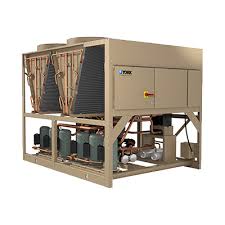Subscribe AfreenAli on YouTube
Prepare By Syed M Afreen Ali (MSc / BS Engineering)
Reciprocating chiller:

Centrifugal Chillers

Screw Chillers

Scroll Chillers

Prepare By Syed M Afreen Ali (MSc / BS Engineering)
Reciprocating chiller:
Reciprocating compressors are categorized as positive displacement machines. These
are available in two basic types: hermetic sealed units and units of open construction. In
hermetic sealed units, the motor and the compressor are direct-coupled and housed in a
single casing that is sealed to the atmosphere. In open construction units, the motor and
the compressor are in separate housings. In general, open construction units have a
longer service life, lower maintenance requirements and higher operating efficiencies.
The hermetic sealed units are most common particularly in small capacities. Single stage
reciprocating machines have an ability to operate at compression ratios of 10 to 12.
The capacity control in reciprocating machine is achieved through ‘On-Off’ or ‘LoadingUnloading’ of compressor cylinders.
Reciprocating machines are manufactured in capacities from 0.5 to 150 TR.
The main factors favoring reciprocating machine is low cost. The other advantage is that
multiple reciprocating machines can be installed to closely match the building loads.
Multiple units allow flexibility to operate machines per the need. If properly managed this
could attribute to significant energy savings during low loads.
A major drawback is a high level of maintenance requirement’s, noise and vibration.
Since the capacity is limited to 150 TR, multiple units cost more than other options.
Multiple chiller configurations require large space and consume more energy per ton of
refrigeration.
Centrifugal Chillers
Centrifugal chillers are categorized as variable volume displacement units. Like
reciprocating machines these are also available in both hermetic and open construction.
Commercially the hermetic sealed units are more widely used, despite its lower operating
efficiency. Centrifugal chillers for refrigeration applications are generally designed for a
fixed compression ratio of 18.
The capacity control is achieved through the use of inlet vanes on the impellers that
restrict refrigerant flow.
The centrifugal chillers are manufactured in capacities from 90 to 2000 tons.
The main factor favoring centrifugal machine is their high operational efficiency at full
load, compact size and availability in large sizes.
The biggest drawback of centrifugal machine is a very poor part load performance and
inability to operate at low cooling loads. At extreme low loads, these chillers are prone to
a condition known as surging.
The main limitation is that these are not suitable for air-cooled condenser options and
require water and cooling tower.
Screw Chillers
Rotary or screw chillers, like reciprocating machines are positive displacement
compressors. Rotary is a wider term that may include vane, eccentric, gear or screw
types. The commercial refrigeration installation rely more on screw machines. Screw
compressors are available in several designs, both single screw and twin screw, with oilfree and oil-injected designs in both types. Twin-screw oil-injected compressors are
slightly more energy efficient at moderate compression ratios. Twin-screw compressors
have an ability to operate at compression ratio of 30. Units are available in both hermetic
sealed and open construction.
The capacity control in screw compressor is achieved thorough a moveable slide stop
valve, which will vary the compressor internal volume ratio to achieve optimum energy
consumption during part load operation.
Screw chillers are available in capacities ranging from 20 to 1000 tons and even higher
from few manufacturers.
The factors favoring screw chillers is their compact size, lightweight, quite & vibration free
operation and high energy efficiency both in full and part load operation.
The major drawback is their high cost. For smaller loads, reciprocating machines are less
expensive to purchase and for large loads centrifugal machines cost less.
Scroll Chillers
Scroll compressors have been used in commercial practice for systems that have
capacity less than 30 TR. On such small sizes, these do not affect the life cycle
economics drastically and therefore not discussed further.
No comments:
Post a Comment